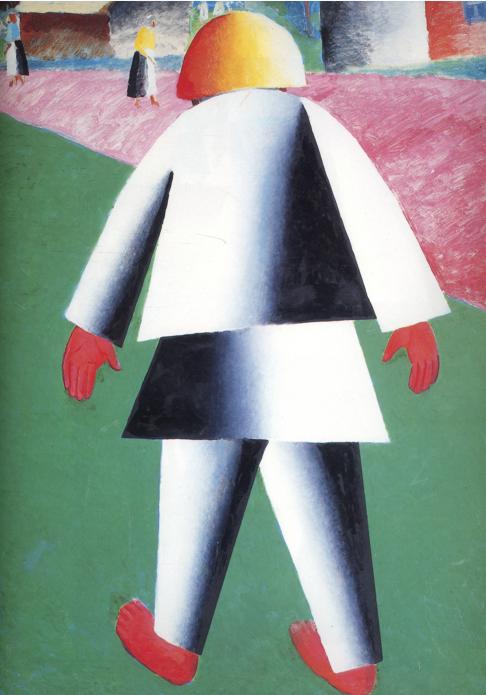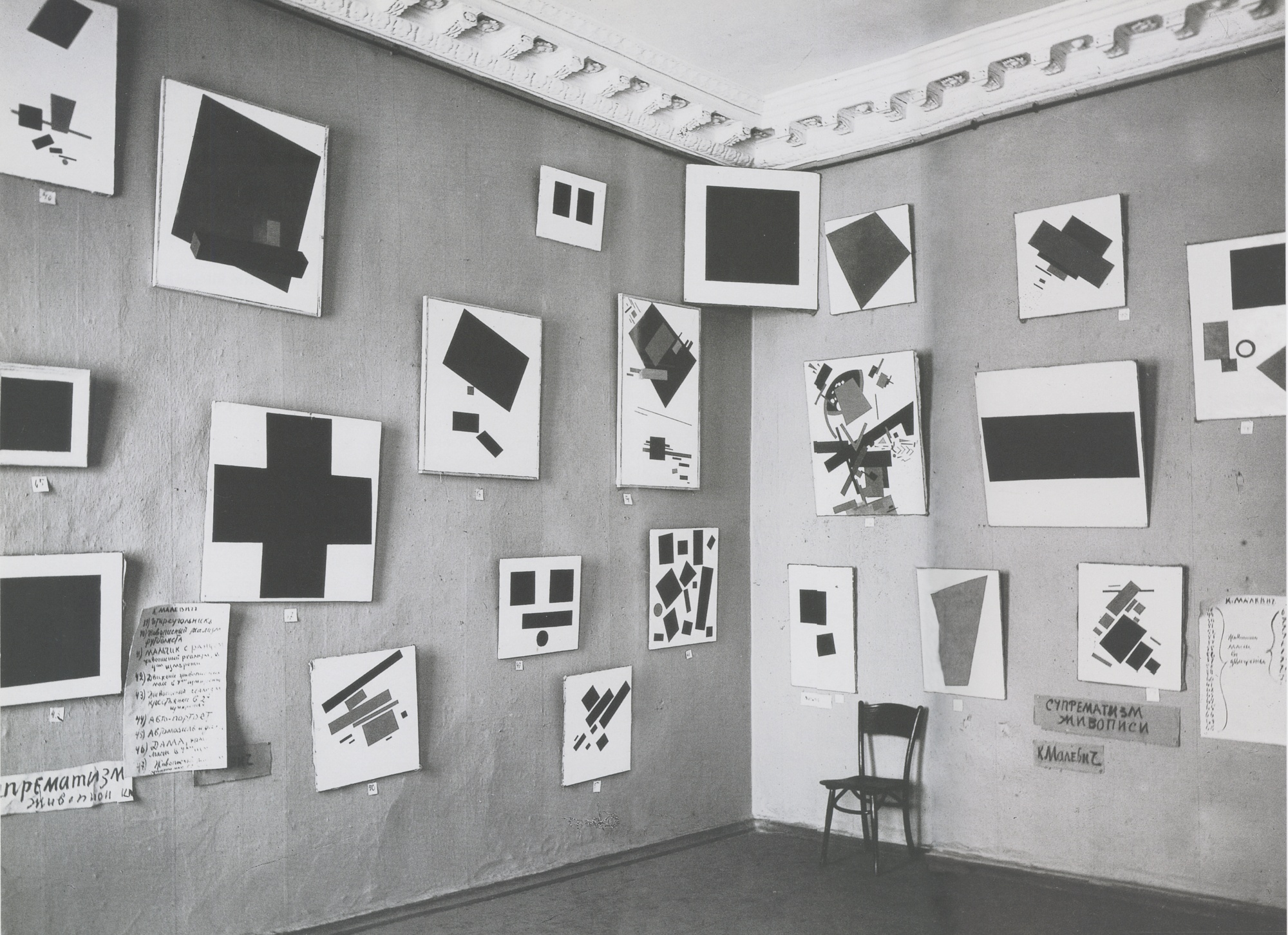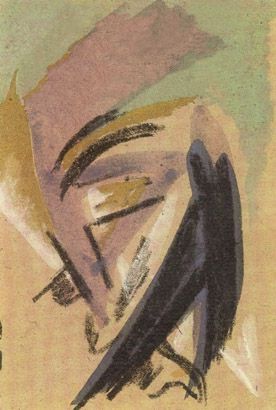|
Suprematism
Suprematism (russian: Супремати́зм) is an early twentieth-century art movement focused on the fundamentals of geometry (circles, squares, rectangles), painted in a limited range of colors. The term ''suprematism'' refers to an abstract art based upon "the supremacy of pure artistic feeling" rather than on visual depiction of objects. Founded by Russian artist Kazimir Malevich in 1913, Supremus ( Russian: Супремус) conceived of the artist as liberated from everything that pre-determined the ideal structure of life and art. Projecting that vision onto Cubism, which Malevich admired for its ability to deconstruct art, and in the process change its reference points of art, he led a group of Ukrainian and Russian avant-garde artists — including Aleksandra Ekster, Liubov Popova, Olga Rozanova, Ivan Kliun, Ivan Puni, Nadezhda Udaltsova, Nina Genke-Meller, Ksenia Boguslavskaya and others — in what's been described as the first attempt to independently foun ... [...More Info...] [...Related Items...] OR: [Wikipedia] [Google] [Baidu] |
Kazimir Malevich
Kazimir Severinovich Malevich ; german: Kasimir Malewitsch; pl, Kazimierz Malewicz; russian: Казими́р Севери́нович Мале́вич ; uk, Казимир Северинович Малевич, translit=Kazymyr Severynovych Malevych ., group=nb (Запись о рождении в метрической книге римско-католического костёла св. Александра в Киеве, 1879 год // ЦГИАК Украины, ф. 1268, оп. 1, д. 26, л. 13об—14. – 15 May 1935) was a ... [...More Info...] [...Related Items...] OR: [Wikipedia] [Google] [Baidu] |
0,10 Exhibition
The Last Futurist Exhibition of Paintings 0,10 (pronounced "zero-ten") was an exhibition presented by the Dobychina Art Bureau at Marsovo Pole, Petrograd, from 19 December 1915 to 17 January 1916. The exhibition was important in inaugurating a form of non-objective art called Suprematism, introducing a daring visual vernacular composed of geometric forms of varying colour, and in signifying the end of Russia's previous leading art movement, Cubo-Futurism, hence the exhibition's full name. The sort of geometric abstraction relating to Suprematism was distinct in the apparent kinetic motion and angular shapes of its elements. Origin of the name The mysterious number 0,10 refers to a figure of thought: Zero, either because it was expected that after the destruction of the old world, the year zero could begin again, or because the artists exhibiting wanted to find the core of painting, and ten, because ten artists were originally scheduled to participate. In fact, there were four ... [...More Info...] [...Related Items...] OR: [Wikipedia] [Google] [Baidu] |
Nina Genke-Meller
Nina Henrichovna Genke or Nina Henrichovna Genke-Meller, or Nina Henrichovna Henke-Meller (russian: Нина Генке-Меллер, Нина Генке; 19 April 1893 – 25 July 1954) was a Ukrainian-Russian avant-garde artist, (Suprematist, Futurist), designer, graphic artist and scenographer. Biography Nina Genke was born in Moscow in 1893 to a Dutch father, Genrikh Genke, and a Russian mother, Nadezhda Tikhanova. She married the artist Vadym Meller (1884-1962). Nina Genke-Meller died in Kyiv in 1954. Education In 1912 she graduated from Levandovskaya Private Gymnasium in Kyiv. She received a title to teach Russian language and history. The following year she began teaching history, geography and drawing at the Higher Primary College for Women in . In Skoptsi, she met the artist Yevgenia Pribylska who headed the Art Studio in a Folk Center and became more inspired to become an artist herself. In 1914 Genke began attending Aleksandra Ekster’s studio in Kyiv for her a ... [...More Info...] [...Related Items...] OR: [Wikipedia] [Google] [Baidu] |
Lyubov Popova
Lyubov Sergeyevna Popova (russian: Любо́вь Серге́евна Попо́ва; April 24, 1889 – May 25, 1924) was a Russian-Soviet avant-garde artist, Painting, painter and designer. Early life Popova was born in Ivanovskoye District, Ivanovskoe, near Moscow, to the wealthy family of Sergei Maximovich Popov, a very successful textile merchant and vigorous patron of the arts, and Lyubov Vasilievna Zubova, who came from a highly cultured family. Lyubov Sergeyevna had two brothers and a sister: Sergei was the eldest, then Lyubov, Pavel and Olga. Pavel became a philosopher and the guardian of his sister's artistic legacy.Dabrowski, M., ''Liubov Popova'', Museum of Modern Art, New York, 1991, p.122. Popova grew up with a strong interest in art, especially Italian Renaissance painting. At eleven years old she began formal art lessons at home; she was first enrolled in Yaltinskaia's Women's Gymnasium, then in Arseneva's Gymnasium in Moscow. By the age of 18 she was studying ... [...More Info...] [...Related Items...] OR: [Wikipedia] [Google] [Baidu] |
Black Circle
''Black Circle'' (or ''motive 1915'') is a 1924 oil on canvas painting by the Kiev-born Russian artist Kazimir Malevich, founder of the Russian Suprematism movement. From the mid-1910s, Malevich abandoned any trace of figurature or representation from his paintings in favour of pure abstraction. The work depicts a monumental perfect black circle floating on a flat white background. It is, along with his ''Black Square'' of 1915, one of his most well known early works in this field, depicting pure geometrical figures in primary colours.Farthing, 617 The motif of a black circle was displayed in December 1915 at the '0.10' Exhibition in St. Petersburg along with 34 other of his abstract works. The exhibition coincided with the publication of his manifesto "From Cubism to Suprematism" and launched the radical Suprematism movement. Malevich described the painting, along with the similar ''Black Square'' and ''Black Cross'' (both 1915), in spiritual terms; "new icons" for the aestheti ... [...More Info...] [...Related Items...] OR: [Wikipedia] [Google] [Baidu] |
Liubov Popova
Lyubov Sergeyevna Popova (russian: Любо́вь Серге́евна Попо́ва; April 24, 1889 – May 25, 1924) was a Russian-Soviet avant-garde artist, painter and designer. Early life Popova was born in Ivanovskoe, near Moscow, to the wealthy family of Sergei Maximovich Popov, a very successful textile merchant and vigorous patron of the arts, and Lyubov Vasilievna Zubova, who came from a highly cultured family. Lyubov Sergeyevna had two brothers and a sister: Sergei was the eldest, then Lyubov, Pavel and Olga. Pavel became a philosopher and the guardian of his sister's artistic legacy.Dabrowski, M., ''Liubov Popova'', Museum of Modern Art, New York, 1991, p.122. Popova grew up with a strong interest in art, especially Italian Renaissance painting. At eleven years old she began formal art lessons at home; she was first enrolled in Yaltinskaia's Women's Gymnasium, then in Arseneva's Gymnasium in Moscow. By the age of 18 she was studying with Stanislav Zhukovsky, and ... [...More Info...] [...Related Items...] OR: [Wikipedia] [Google] [Baidu] |
Olga Rozanova
Olga Vladimirovna Rozanova (also spelled Rosanova, Russian: Ольга Владимировна Розанова) (22 June 1886 – 7 November 1918, Moscow) was a Russian avant-garde artist painting in the styles of Suprematism, Neo-Primitivism, and Cubo-Futurism. Biography Early life Olga Rozanova was born in Melenki, a small town near Vladimir. Her father, Vladimir Rozanov, was a district police officer and her mother, Elizaveta Rozanova, was the daughter of an Orthodox priest. She was the family's fifth child; she had two sisters, Anna and Alevtina, and two brothers, Anatolii and Vladimir. Rozanova's father died in 1903, and her mother became the head of the household. She graduated from the Vladimir Women's Gymnasium in 1904. Due to her interest in the avant-garde movement, she moved to Moscow to study painting. Artistic career After arriving in Moscow, she attended the Bolshakov Art School, where she worked under Nikolai Ulyanov and sculptor Andrey Matveev. She aud ... [...More Info...] [...Related Items...] OR: [Wikipedia] [Google] [Baidu] |
Cubo-futurism
Cubo-Futurism (also called Russian Futurism or Kubo-Futurizm) was an art movement that arose in early 20th century Russian Empire, defined by its amalgamation of the artistic elements found in Italian Futurism and French Analytical Cubism. Cubo-Futurism was the main school of painting and sculpture practiced by the Russian Futurists. In 1913, the term ‘Cubo-Futurism’ first came to describe works from members of the poetry group ‘Hylaeans’, as they moved away from poetic Symbolism towards Futurism and ''zaum'', the experimental “visual and sound poetry of Kruchenykh and Khlebninkov”. Later in the same year the concept and style of ‘Cubo-Futurism’ became synonymous with the works of artists within Ukrainian and Russian post-revolutionary avant-garde circles as they interrogated non-representational art through the fragmentation and displacement of traditional forms, lines, viewpoints, colours, and textures within their pieces. The impact of Cubo-Futurism was then ... [...More Info...] [...Related Items...] OR: [Wikipedia] [Google] [Baidu] |
Black Square (painting)
''Black Square'' (also known as ''The Black Square'' or ''Malevich's Black Square'') is an iconic painting by Kazimir Malevich. The first version was done in 1915. Malevich made four variants of which the last is thought to have been painted during the late 1920s or early 1930s. ''Black Square'' was first shown in The Last Futurist Exhibition 0,10 in 1915. The work is frequently invoked by critics, historians, curators, and artists as the "zero point of painting", referring to the painting's historical significance and paraphrasing Malevich. History The Black Square first appeared as part of a design for a stage curtain in the 1913 Russian Futurist/Cubo-Futurist opera '' Victory over the Sun'' by Velimir Khlebnikov, Aleksei Kruchyonykh, and Mikhail Matyushin, for whom he did the costume and stage designs. Malevich painted his first ''Black Square'' in 1915. He made four variants, of which the last is thought to have been painted during the late 1920s or early 1930s, despite ... [...More Info...] [...Related Items...] OR: [Wikipedia] [Google] [Baidu] |
Nadezhda Udaltsova
Nadezhda Andreevna Udaltsova (, 29 December 1885 – 25 January 1961) was a Russian avant-garde artist (Cubist, Suprematist), painter and teacher. Early life and education Nadezhda Udaltsova was born in the village of Orel, Russia, on 29 December 1885. When she was six, her family moved to Moscow, where she graduated from high school and began her artistic career. In September 1905 Udaltsova enrolled in the art school run by Konstantin Yuon and Ivan Dudin, where she studied for two years and met fellow-students Vera Mukhina, Liubov Popova, and Aleksander Vesnin. In the spring of 1908 she traveled to Berlin and Dresden, and upon her return to Russia, she unsuccessfully applied for admission to the Moscow Institute of Painting, Sculpture, and Architecture. She also married Alexander Udaltsov, her first husband, in 1908. In 1910–11, Udaltsova studied at several private studios, among them Vladimir Tatlin's. In 1912–13 she and Popova traveled to Paris to continue their studie ... [...More Info...] [...Related Items...] OR: [Wikipedia] [Google] [Baidu] |
Ivan Puni
Ivan Albertovich Puni (russian: Иван Альбертович Пуни; also known as Jean Pougny; 20 February 1892 – 28 December 1956) was a Russian avant-garde artist (Suprematist, Cubo-Futurist). Biography Early life Ivan Puni was born in Kuokkala (then Grand Duchy of Finland in the Russian Empire, now Repino in Russia) to a family of Italian origins. He was the grandson of an eminent Italian composer of ballet music, Cesare Pugni. His father, a cellist, insisted that he follow a military career, but Ivan instead decided to take private drawing lessons with Ilya Repin. By 1909, he had his own studio. Career Puni continued his formal training in Paris in 1910–11 at the Académie Julien and other schools, where he painted in a derivative ''fauviste'' style. Upon his return to Russia in 1912, he married fellow artist Kseniya Boguslavskaya, and met, and exhibited with, members of the St Petersburg avant-garde, including Kazimir Malevich and Vladimir Tatlin. He made a secon ... [...More Info...] [...Related Items...] OR: [Wikipedia] [Google] [Baidu] |
Constructivism (art)
Constructivism is an early twentieth-century art movement founded in 1915 by Vladimir Tatlin and Alexander Rodchenko. Abstract and austere, constructivist art aimed to reflect modern industrial society and urban space. The movement rejected decorative stylization in favor of the industrial assemblage of materials. Constructivists were in favour of art for propaganda and social purposes, and were associated with Soviet socialism, the Bolsheviks and the Russian avant-garde. Constructivist architecture and art had a great effect on modern art movements of the 20th century, influencing major trends such as the Bauhaus and De Stijl movements. Its influence was widespread, with major effects upon architecture, sculpture, graphic design, industrial design, theatre, film, dance, fashion and, to some extent, music. Beginnings Constructivism was a post-World War I development of Russian Futurism, and particularly of the 'counter reliefs' of Vladimir Tatlin, which had been exhibited ... [...More Info...] [...Related Items...] OR: [Wikipedia] [Google] [Baidu] |



_1.jpg)



.jpg)

.jpg)
